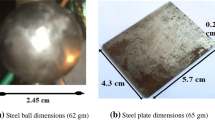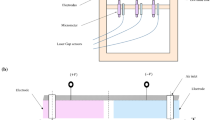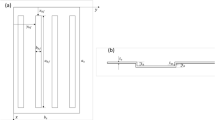Abstract
This paper presents a comparative study on the design, modelling, electromagnetic analysis based on finite-element software, fabrication and experiment on rectangular flat (148 g) and C-shaped (148 g) levitation prototypes based on steel plates. No mechanical restrainer has been used in the transverse direction for the levitation. This aspect of the work is an improvement over existing work reported in the published literature. The entire set-up has been designed, fabricated, analytically investigated and experimentally evaluated and verified. The finite-element model (FEM) has been derived using standard commercial package(s). The analytical model has been obtained using specific permeance concepts following Robert Pohl’s method. Excellent correlation between the predicted and experimental results is a highlight of the work. The stability against transverse mechanical perturbation has also been investigated. Control system design and implementation is successfully done.
























































Similar content being viewed by others
References
Sinha P K 1987 Electromagnetic suspension: dynamics and control. London, U.K.: Peter Peregrinus
Bittar A, Cruz J J and Sales R M 1998 A new approach to the levitation control of an electromagnetic suspension vehicle. In: Proceedings of the IEEE Conference on Control Applications, pp. 263–270
Jayawant B V 1988 Review lecture on electromagnetic suspension and levitation techniques. Proc. R. Soc. Lond. 416: 245–320
Kundu J, Sengupta M and Sengupta A 2013 Design, modelling, fabrication and testing of an electromagnetic coil system for a levitation mechanism. In: Proceedings of NPEC
Earnshaw S 1842 On the nature of the molecular forces which regulate the constitution of the luminiferous ether. Trans. Cambridge Philos. Soc. 7: 97–112
Wong T H 1986 Design of a magnetic levitation control system. IEEE Trans. Educ. E-29(4): 196–200
Moon F C 1994 Superconducting levitation: applications to bearings and magnetic transportation. USA: John Wiley and Sons
Rogg D 1984 General survey of the possible applications and development tendencies of magnetic levitation technology. IEEE Trans. Magnet. 20: 1696–1701
Pal J, Prasad D and Banerjee S 2002 A unifying approach for development of magnetically suspended vehicle using controlled DC electromagnet. In: Proceedings of the International IEEE-ACE (EPIC) Conference, pp. 404–408
Morishita M and Azukizawa T 1988 Zero power control method for electromagnetic levitation system. IEE Proc. 108(45): 447–451
Shiao Y S 2001 Design and implementation of a controller for a magnetic levitation system. Proc. Natl. Sci. Counc. 11: 88–94
Chen J and Tsukamoto O 1991 Attractive type magnetic levitation system with 3 AC electro-magnets. In: Proceedings of the IEEE International IECON Conference, vol. 1, pp. 778–782
Moriyama S 2000 AC magnetic suspension using a differential feedback power amplifier. In: Proceedings of the International Conference on Electrical Engineering, vol. 131, pp. 61–67
Tsukamoto O, Yasuda K and Chen J Z 1988 A new magnetic levitation system with AC magnets. IEEE Trans. Magnet. 24: 1497–1502
Yamamura S and Yamaguchi H 1990 Electromagnetic levitation system by means of salient-pole type magnets coupled with laminated slotless rails. IEEE Trans. Veh. Techol. 39: 83–88
Matsumura F and Yamada S 1974 A method to control the suspension system utilizing magnetic attractive force. Electr. Eng. Jpn. 94(6): 50–54
Oliveira V A, Costa E F and Vargas J B 1999 Digital implementation of a magnetic suspension system for laboratory experiments. IEEE Trans. Educ. 42: 315–319
Jayawant B V 1988 Review lecture on electromagnetic suspension and levitation techniques, https://www.jstor.org/stable/pdf/2398062.pdf
Banerjee S, Kumar T K S, Pal J and Prasad D 2008 Controller design for large-gap control of electromagnetically levitated system by using an optimization technique. IEEE Trans. Control Syst. Technol. 16(3): 408–415
Sengupta M and Sengupta A 2001 Design, implementation and testing of an attraction type magnetic levitation system. In: Proceedings of the International EAIT Conference, pp. 17–20
Pohl R 1946 Theory of pulsating field machines. J. Inst. Electr. Eng. 93(64): 37–47
Venkataratnam K, Bhattacharya T K and Sengupta M 1998 Theory, performance prediction and indirect sensing of rotor position in a switched reluctance motor under bulk saturation. IEE Proc. – Electr. Power Appl. 146(6): 667
Bimbhra P S 2009 Electrical machinery, 2nd ed. Khanna Publishers
Acknowledgements
The authors acknowledge the support received from CSIR (Government of India) in the form of fellowship received by one of the authors. The help received from the Central Tool Room and Training Centre (CTTC, Kolkata), an MSME concern under the Government of India, is also duly acknowledged. The support of the Institute authorities, the Department of Electrical Engineering and the research colleagues, particularly Mr P Mukherjee at the Advanced Power Electronics (APE) Laboratory, Department of Electrical Engineering, IIEST, Shibpur, is also gratefully acknowledged. Special mention is made of the co-operation received from Mr N Dutta, Project Technical Assistant at the APE Laboratory.
Author information
Authors and Affiliations
Corresponding author
Rights and permissions
About this article
Cite this article
Kundu, J., Sengupta, M. Design, analysis, fabrication, control and comparative study of two different-shaped plate levitation prototypes. Sādhanā 45, 53 (2020). https://doi.org/10.1007/s12046-020-1284-9
Received:
Revised:
Accepted:
Published:
DOI: https://doi.org/10.1007/s12046-020-1284-9




